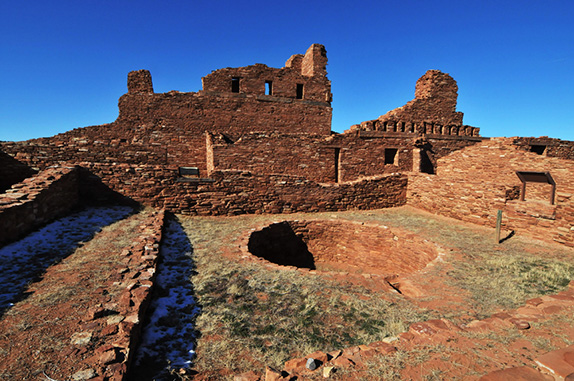 (Abó)
(Abó)
There are two sorts of ruins, or at least ruins in which two different energies motivated their construction. The most prevalent, from ancient times, are sites where royalty enlisted the labor of slaves, or paid as little as the era allowed to armies of workers who built the cities of their dreams. The pyramids at Giza, the great Maya or Inca cities to our south, Angkor and the other great monuments of Southeast Asia, even Europe’s gothic cathedrals fall into this category.
The second energy can be felt in the ruins of cities or smaller communities where men and women came together to build a place for themselves to live. Free of outside oppression. Simple as that. Evidence of innovation and cooperation remains. These places were not constructed on such a monumental scale. Utilitarianism trumped grandeur. Yet beauty and grace can be seen in what remains of walls and rooms, storage bins and structures for communal gathering.
Throughout the world we find sites in both these categories. In the latter, one that is particularly amazing is the vast array of stupas in the Burmese city of Bagan. In less than twenty square miles, close to 2,000 individual families erected these monuments to their dead—some modest, some large and elaborate, depending upon each family’s possibilities. Generation to generation each family has kept up its own stupa. The sun illuminating all those spires of red brick against a field of intense green will always be with me. Our own southwestern United States is also rich in ruins of the second sort, once inhabited by our Ancestral Puebloan ancestors.
In fact, here in New Mexico we have examples of both types of site. Chaco and its outliers are among the most important remnants of locations where areas designated for ritual overshadow living quarters, but a particular culture’s hand can be felt throughout. And then there is Salinas Pueblo Missions National Monument, in the southern part of our state, where Franciscan missionaries from Spain enlisted the labor of Tiwa and Tompiro Indians in the erection of imposing churches. Adjacent living quarters, at least in their ruined state, seem almost a begrudging afterthought.
The configurations at Salinas mimic tens of thousands of Iberian and later Latin American villages, where a central church dwarfs the surrounding dwellings. Anyone who has traveled has visited places like this, perhaps commenting on the inequality. Of course you don’t need to travel to see that inequality. It is all around us. Here in Albuquerque, consider the architectural wealth and inner trappings of any school in an upper-class neighborhood compared with one in poorer sections of the city. The citywide tax base is supposed to support them in equal measure, but that’s a joke.
Where religious edifices are concerned, parishioners are urged to tithe heavily, and the contrast between impoverished homes and exuberant temples can be stark. Churches have always made outrageous overlords, bleeding their congregants dry and promising a reward that would only come after death. This sort of governance, in religious or secular form, continues throughout the world today. It may produce imposing architecture and exquisite art, but its record in terms of caring for the human beings whose lives are spent in the building isn’t so great.
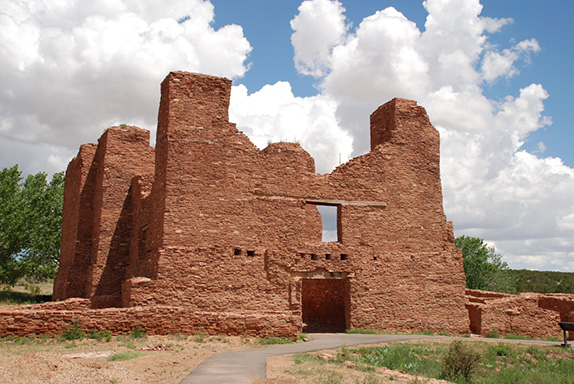 (Quarai)
(Quarai)
We have interesting examples of this historic control in the southeastern part of New Mexico. The three sites that make up Salinas—Quarai, Abó, and Gran Quivira—are quite different, one from another. Together, or even separately, they are a fascinating destination. From Albuquerque one can drive east on I-40, then south at Moriarity and down through Estancia to Mountainair. If you choose to go this way, slow to a crawl and be sure all seatbelts are fastened when passing through Estancia, as the village seems to make a fair amount of its income trapping unsuspecting motorists.
Or, you can drive directly south from Albuquerque on I-25 and turn east toward Mountainair on State Highway 60 south of Belen. On the first route, you’ll reach Quarai and Gran Quivira first, on the second Abó. Either way, Mountainair is the only town within miles. It’s a small community of old timers with a newer influx of iconoclastic artists and one very interesting old hotel and restaurant. But more about Mountainair later.
Either way you choose to arrive, you will be among the sparse number of visitors these sites attract. I am always astonished at how few people seem to know about Salinas, or be interested in visiting its treasures. The guest book at Quarai only shows some 30 to 50 signatures a day. I would venture a guess that the other two receive about the same amount.
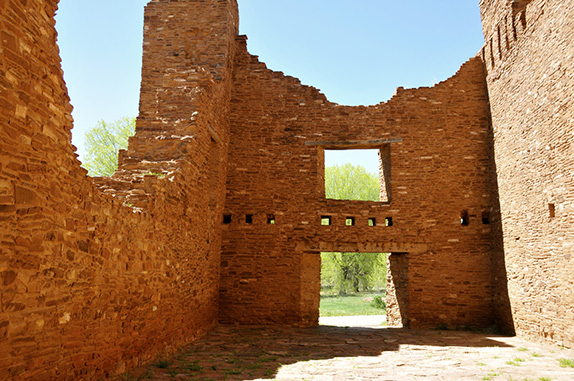 (Quarai)
(Quarai)
Nestled in the grasslands of this isolated part of the state, each of these discrete ruins is built around a 17th century Spanish Franciscan mission church dating from the area’s earliest period of European colonization. This was when the sword and the cross struck the local Tompiro and Tiwa people. Each ruin has as its centerpiece what was once its imposing church, and at Quarai and Abó in particular their still standing walls remain in sweeps of elegant angles and arches with heavy wooden lintels and well-shaped windows. Although these sites were abandoned in the late 17th century, the dry climate, general remoteness, and lack of subsequent settlement have left the remains in excellent condition.
The site farthest to the north, in the foothills of the Manzano Mountains, is Quarai. A large red stone church anchors mostly unexcavated ruins of living quarters and mounds now overgrown by grass. A visitors center and small museum are worth a look, and a quarter-mile paved loop allows visitors to explore the site in an hour or so, though a few beautifully situated picnic tables invite you to stay a while longer. I remember stopping at Quarai one day to find an injured baby owl nested in the interior of the great nave. Monument personnel had roped off a corner where it would not be bothered by the curious or overly eager. A few months later, when we visited again, we were told it had healed well and now made its home in nearby treetops. Quarai has a slight riparian feel, with clusters of cottonwoods.
The church at Quarai was the Misión de Nuestra Señora de la Purísima Concepción. The nave and apse still stand, along with what was once a convent. Remnants of two circular kivas suggest that the missionaries sought to convert the Indians by integrating aspects of their religious practices in a syncretism typical of this sort of conquest.
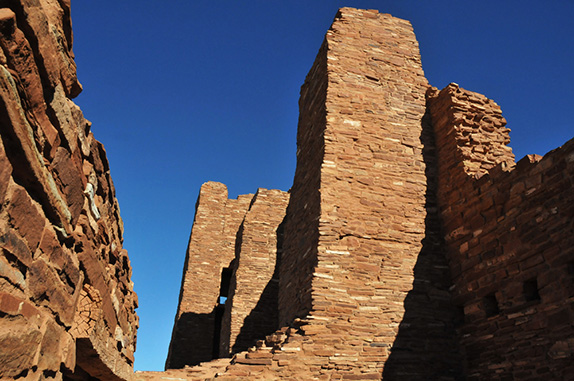 (Abó)
(Abó)
Like Abó, farther south, these ruins bear some resemblance to the much older Ancestral Puebloan ruins in places like Wupatki in Arizona. But here the walls are taller and more sturdily build. They slope slightly inward toward the top. Their windows are intricately constructed, and the entire building was once covered in adobe, though this has long since washed away.
Twelve miles further south, on the other side of Mountainair, is Abó: far and away my favorite of the three sites. No matter how many times I’ve been there, my first glimpse of the mission silhouette on the horizon always takes my breath away. Like Quarai, the building material at Abó is a deep red stone, reflecting the color of the earth. This was the Misión San Gregorio, completed in 1659, with thick buttresses supporting sandstone walls and a wooden stairway once leading to a choir loft. Splayed out from the church are many single-story connected rooms, several kivas, and a number of lesser structures. A half-mile trail allows one access to all excavated parts of the site.
Here the surrounding area is more desert-like, with few trees, and there is an unbroken view across open plains to the mountains beyond. I’ve visited Abó dozens of times over the years, with friends or family or simply with my partner. We’ve walked slowly along its pathways and stood quietly within its roofless chambers or stared absorbed into its several kivas.
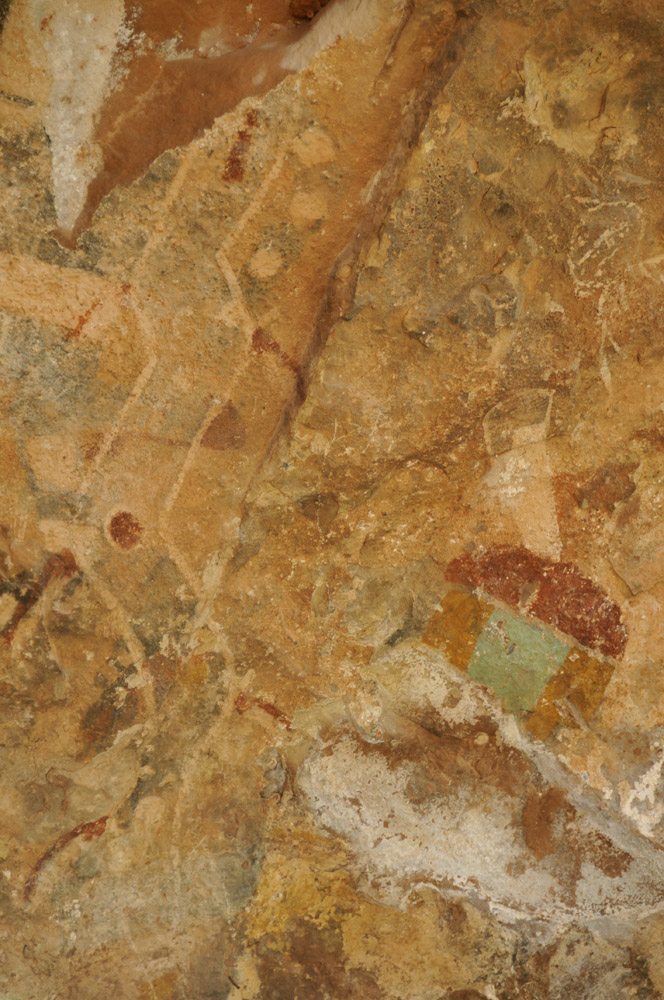 (Tompiro pictographs near Abó)
(Tompiro pictographs near Abó)
At Abó there is an area where dozens of petroglyphs offer clues to how the Tompiro people lived, the images they used to express what was important or longed for, cosmic events and earthly records. But the real treasure at Abó is a series of pictographs—paintings on rock—that may only be visited accompanied by the on-duty archeologist.
As yet lacking the funding needed to protect this extraordinary wall from encroachment and possible vandalism, the Monument does not allow visitors to climb to it on their own. The last time we were there we were with my son and his family, who live in Uruguay. We got lucky; the ranger at the visitor center was able to make contact with the resident archeologist, whose office is in Mountainair, and he was happy to meet us an hour or so later and lead us to the pictographs. His explanations were knowledgeable and exuberant; it was clear he loved his job. The paintings are located in an unmarked spot not far from the ruin. A short scramble over untended rocks brings you to a ledge from which you can look up and view a variety of images, some painted with colors as rich and sustained as those one finds in an Egyptian tomb. Stand there for a moment, allow your eyes to adjust to the gallery before you, and I guarantee you will be awed.
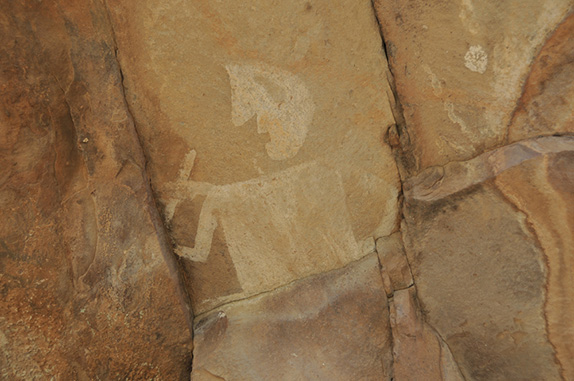 (The Gardener)
(The Gardener)
There are human and animal figures, geometric forms, and one beautifully drawn man wielding an implement of farming or gardening. The friend who first told me about him calls him The Gardener. His stance on that wall speaks volumes about the sort of life the original inhabitants of Abó lived. Their relationship to the earth must have been a good deal more satisfying than that with the Franciscan friars who imposed worship of a foreign god and got them to build a church in its honor.
Most remote of the three sites is Gran Quivira. It is reached by driving 26 miles south of Mountainair, perhaps after enjoying an excellent New Mexican meal at the old Shaffer Hotel, founded by Pop Shaffer in 1923. Or, if you’re the sort of traveler who likes moving slowly and staying at out of the way places, you might even consider spending the night. All the rooms at the Shaffer are furnished with antiques dating to its inception, or pieces crafted by local artists. And Pop Shaffer’s ghost is rumored to roam the premises. Even if you don’t eat or sleep there, it’s worth a stop to look around. The Shaffer, registered as a National Historic site, is one of the few examples of Pueblo-Deco architecture in existence.
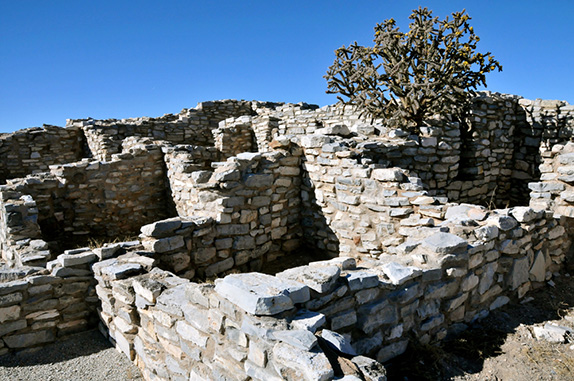 (Gran Quivira)
(Gran Quivira)
Continuing south, Gran Quivira is the most remote of the Salinas ruins and quite different from the other two. The arid cattle ranching country is on rocky gray land, and this ruin is consequently built of gray limestone rather than the rich reddish sandstone of Quarai and Abó. Gran Quivira is a much larger site, as well, with more than 200 rooms and seven kivas. Partial reconstruction has brought the walls here to around three feet in height, reminiscent of Tuzigoot in Arizona. Originally, two churches were planned: the first, Misión San Isidro, completed in 1631, and a second more prominent one to the west, Misión San Buenaventura. The latter was never finished.
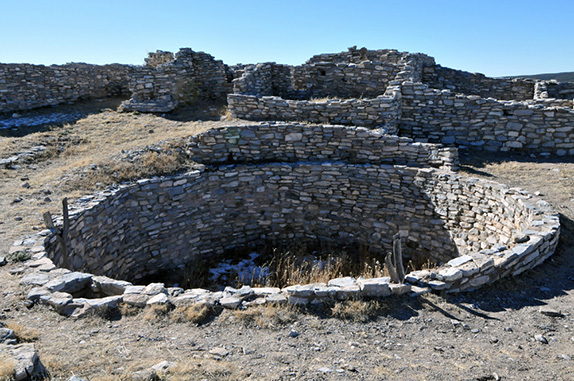 (Gran Quivira)
(Gran Quivira)
The natural beauty of what remains of the three Salinas sites bears the scars of conquest in subtle and not so subtle ways. In contrast with the kivas integrated into the overall design at places such as Kiet Seel, Mesa Verde, and other ancient communities where outside conquest didn’t arrive, here imposing churches overshadowed humble homes, and the residue of unequal power can still be felt.
It is not that we should shun such places; they are beautiful and hold many lessons. Not the least of these is the reminder that we must continue to resist today: every instance of power that erodes our agency, whether in our home, community, nation, or globally. While places like Kiet Seel exude resourcefulness, innovation and pride, place like Salinas speak accommodation, with resistance hidden in its folds.

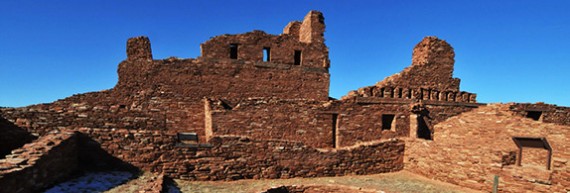


Responses to “Salinas Pueblo Missions: A Lesson in Resistance”